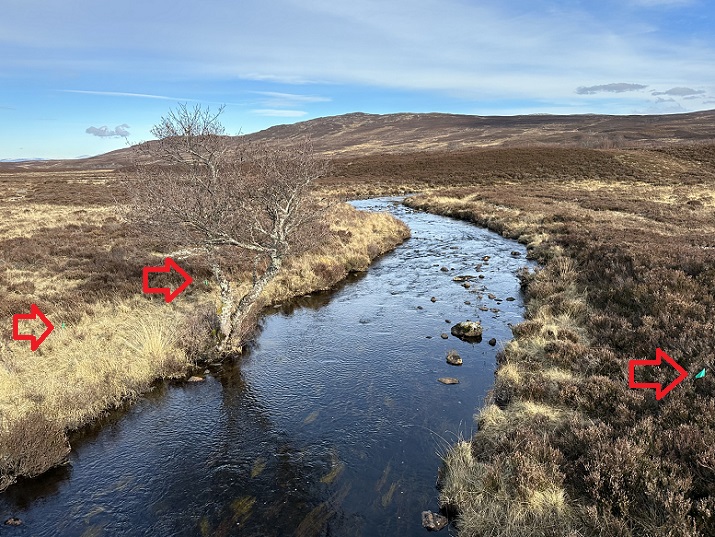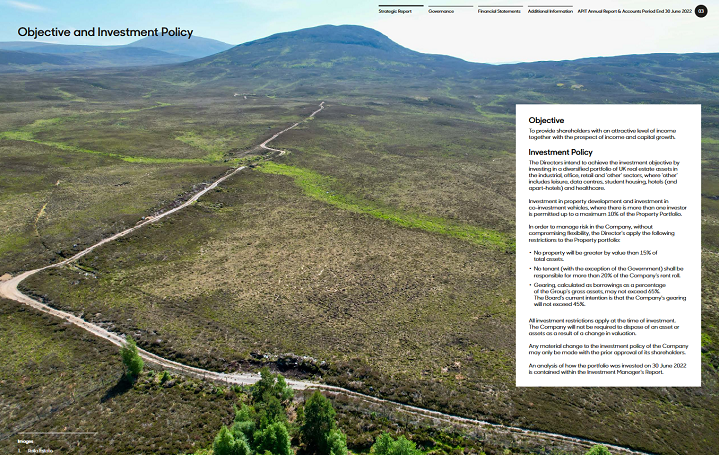
This post takes a further look at what is going on at Far Ralia which was bought in September 2021 by the Standard Life Property and Investment Trust (SLIPIT), renamed the ABDN Property Income Trust last summer.
The Wade bridge
First, a little good news. The gate that featured in my post on the Far Ralia road (see here) has been moved from the Wade Bridge about 100m to the south, out of sight of the historic monument. The Prior Notification SAC Consulting submitted to Highland Council claiming it wished to upgrade the road for forestry purposes made no mention of this gate and there is still nothing about it in the papers on the Highland Council planning portal (see here). It seems likely, however, that is has been moved as a result of discussions between Highland Council and the developer as a result of Laggan Heritage’s excellent comments on the Prior Notification (see link above).
Now the less good news. Laggan Heritage had also raised concerns about the proposal to build a new bridge alongside the old one, the Drochaid Balbh Bhordain, which it described as “one of the finest remaining examples of a single span packhorse bridge on the Wade Road”. That has not stopped little green marker flags, which appear to show the proposed crossing, being placed next to it “in an open landscape, over a sinuous burn in a setting that has changed little in two hundred and fifty years”:

If this is the proposed location, ABDN and its agents should think again. The new concrete bridge would not only be right next door to the Wade Bridge, ruining its setting, it would flatten the only sizeable tree in the area.
A forestry road for what?
ABDN’s interim report and accounts for the half year until 30th June 2022, the most recent information on their website, are quite revealing. They contain this photo showing how the upper section of the road, which ABDN apparently wishes to repair so it can plant more trees above (on further areas of bog as I showed in my last post), cuts through a large area of blanket bog:

The road as a whole effectively acts like a giant drainage ditch through the peat bog. You can also see from the photo the unrestored areas of bank which featured in my last post and serve to drain water from the bog even more quickly.
ABDN’s interim report also contains this brief statement about the land they now own and their intentions:
“Land at Far Ralia: In September 2021 the Company acquired just over 1,440 hectares on unproductive open moorland in Scotland to undertake peatland restoration and reforestation of natural woodlands, with the aim of having a fixed cost carbon offset. Over the last 12 months we have
been undertaking the required consultation and refining the planting plan, with an aim that we can start the planting of the circa 1.5m trees in spring 2023. We are working with Akre Trees, a specialist nursery that has been verified as a carbon negative tree nursery. Akre have been on site collecting seeds from which to grow saplings in their state of the art glasshouse”.
This confirms that ABDN are intending to undertake peatbog restoration at Far Ralia in order to obtain more carbon credits and reinforces the suspicion that the real reason for repairing the road may not be to transport in trees, which could be done with light vehicles, but to bring in diggers to fill in the drainage ditches in the area of bog that lies between Glas-mheall Mor and Glas-mheal Beag (photos in previous post). That might be justified but such a road upgrade would not come under the Prior Notification system and should require full planning permission.
Meantime, for any owner caring about conservation or from the perspective of the Scottish Government which has put so much emphasis on the importance of peat bogs for locking up carbon, why pay to block up drains and leave roads like this in place? Sadly, there are no plans for removing the road in the Prior Notification which was submitted to Highland Council .
Further doubts about the sense of ABDN’s plans are also raised by the reference to Akre Trees and their having been “on site collecting seeds from which to grow saplings”. Akre runs a tree nursery which appears to have grown out of a consultancy, Kilrie Trees, and claims to have advised Standard Life/ABDN about the purchase of Far Ralia (see here). It has now submitted a Felling License to Scottish Forestry (see here) to chop down 3.67ha of native woodland to expand its tree nursery and “compensatory plant the felling area in a different location”. This is all perfectly lawful under our current forestry system but suggests that Akre have little interest in conserving soils, which are far more important than trees for storing carbon, whether this is at their nursery or Far Ralia.
Instead of employing Akre to collect seed from Far Ralia, transporting it to Fife to a nursery and then bringing the saplings back and planting them on what are predominantly peaty soils, why does ABDN not just let the seed regenerate naturally as is happening in Glen Tromie, owned and managed by Wild Land Ltd, just over the hill?
What needs to happen?
Planning Authorities are supposed to decide whether Prior Notifications for forestry tracks require Prior Approval within 28 days. The paperwork claiming the proposals to upgrade the road to and through Far Ralia were submitted on 19th January, over ten weeks ago now, and there is still no sign of a decision by Highland Council although the fact that the gate has been moved, strongly suggests that negotiations have been taking place with the developer behind the scenes.
In the absence of any approved forestry plan – the proposed tree planting is now thankfully well behind schedule – and given ABDN’s stated intention to undertake peatbog restoration on site, there are strong reasons to believe the main purpose of the track upgrade is not for forestry purposes and therefore that it should require full planning permission. Were Highland Council to take that decision, I would expect the Cairngorms National Park Authority, which has a presumption against new roads on moorland, to call the application in and force ABDN into a re-think.
Meantime, ABDN should be basing their plans for Far Ralia on re-wilding principles, not advice from consultants who are using the public grants system to offset the financial costs of carbon offsetting for private landowners. This serves to undermine claims from NatureScot and our National Park Authorities that green finance from the city has an important role to play in restoring nature.

The blind mindset of this big money enterprise is on display from the very outset of this ecologically daft proposal
“the Company acquired just over 1,440 hectares on UNPRODUCTIVE open moorland in Scotland” ( my capitals.)
Does the use of such a prejudiced adjective not point to practically everything that is wrong with the modern approach to Scotland’s rural planning process.? The fact that no man-made structure, track, or unnatural watercourse is visible, should never imply the landscape is vacant and useless, and thus, ripe for development.
Maybe future generations will never know that until so very recently timeless vistas existed across Scotland; a Halcyon time before short-term money-grabbing interference by distant global corporations.
The reason for such ridiculous logistics for supposedly “storing carbon” is the gravy train of payments engineered by economists to given large landowners loads of dosh to “save us all” from a the gas that is food for photosynthetic organism in the first instance. Climate has always changed. Maybe the purpose of humans was always to recycle the carbon that had been stored in fossil fuels back into circulation in the carbon cycle so photosynthetic organism could grow closer to their optimal levels.
Some good comments by others and I can only add that as we have an already inept and inadequate party of Government running our Scottish Exec. now in more turmoil from their own shenanigans, land owners will have nobody to effectively scrutinise their actions let alone actually hold them to account.
On a personal note of feeling, I think that this is yet another example of the persistent nibbling away of our upland and mountain environment. We are leaving the next generations a mess.
Surely Highland Council can see through the web of deceit that ABDN is casting???? My problem is I doubt it. Meanwhile CNPA just sits on the sidelines, instead of being pro-active. Yes, there are policies, plans and objectives piled high, but what is needed is action to stop this deception by ABDN who have little interest in the natural environment, and are only motivated by carbon offset as a financial tool.
Hello. I am responsible for the project at Far Ralia and we are managing it on behalf of Abrdn. If you would like any clarification on any points, please let me know. Below is a brief summary:
The project is a native woodland restoration project with peatland restoration. The woodland is a combination of ancient Caledonian pine, upland birch and motane scrub. None of the woodland is for timber. The carbon sequestered will be used to offset Abrdn’s carbon footprint. It is not their intention to sell it. They have used their need for carbon offset to justify investing in a landscape-scale ecological restoration project. We have used the Natural History Museum to analyse the land alongside extended phase one habitat, breeding bird surveys and peat depth and condition surveys. We conducted a two-day consultation in Newtomoore Village Hall to gather local information and incorporated this into the design. The design combines natural regeneration, native woodland creation and peatland restoration.
Without welcoming this type of investment into the rural economy, we will struggle to restore our degraded ecosystems. The Natural History Museum found that currently Far Raila’s biodiversity Intacdness is at 59.60 out of 100. To be sustainable, i.e. to stabilise and not decline, it needs to be above 80. This is called the planetary boundary or threshold for biodiversity. Our design and intervention will increase the biodiversity intactness on this land to 88.43 in the long term. In addition, we are improving the access to the hill so that people can enjoy it. In the short term, it will require up to 100 people working over the next 3 years to get the bulk of the work done. The woodland creation and peatland restoration require excavators so we need to make sure the access is capable of handling these without damaging the watercourse.
Our contractors put the gate too close to the bridge so we had it moved. We also agree that the engineers who flagged the bridge managed to find the only tree as far as the eye can see which is staggering! This has also been moved away from the beautiful Wades Bridge. We do listen and adapt our plans. We don’t always respond to every issue but on the whole, we try to.
While Abrdn is taking its climate commitments seriously, they are trying to use that to enable ecological restoration and enhance the landscape. Their and our intentions are good and science-based. This type of collaboration could really improve the landscape and provide jobs for rural communities, particularly on ground like this, where there has been no productive farming or sporting interest for the last 10 years.
I hope we can continue to have a constructive discourse to resolve any issues that are raised. I will keep checking here for any issues and I hope to be as helpful and forthcoming as I can be.